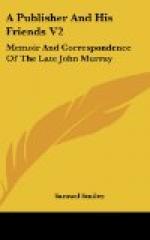Notwithstanding this adverse judgment, Mr. Murray was disposed to buy the Memoirs. Lord Holland drove a very hard bargain, and endeavoured to obtain better terms from other publishers, but he could not, and eventually Mr. Murray paid to Lord Waldegrave, through Lord Holland, the sum of L2,500 on November 1, 1821, for the Waldegrave and Walpole Memoirs. They were edited by Lord Holland, who wrote a preface to each, and were published in the following year, but never repaid their expenses. After suffering considerable loss by this venture, Mr. Murray’s rights were sold, after his death, to Mr. Colburn.
The last of the memoires pour servir to which we shall here refer was the Letters of the Countess of Suffolk, bedchamber woman to the Princess of Wales (Caroline of Anspach), and a favourite of the Prince of Wales, afterwards George II. The Suffolk papers were admirably edited by Mr. Croker. Thackeray, in his “Lecture on George the Second,” says of his work: “Even Croker, who edited her letters, loves her, and has that regard for her with which her sweet graciousness seems to have inspired almost all men, and some women, who came near her.” The following letter of Croker shows the spirit in which he began to edit the Countess’s letters:
Mr. Croker to John Murray.
May 29, 1822.
DEAR MURRAY,
As you told me that you are desirous of publishing the Suffolk volume by November, and as I have, all my life, had an aversion to making any one wait for me, I am anxious to begin my work upon them, and, if we are to be out by November, I presume it is high time. I must beg of you to answer me the following questions.
1st. What shape will you adopt? I think the correspondence of a nature rather too light for a quarto, and yet it would look well on the same shelf with Horace Walpole’s works. If you should prefer an octavo, like Lady Hervey’s letters, the papers would furnish two volumes. I, for my part, should prefer the quarto size, which is a great favourite with me, and the letters of such persons as Pope, Swift, and Gay, the Duchesses of Buckingham, Queensberry, and Marlbro’, Lords Peterborough, Chesterfield, Bathurst, and Lansdowne, Messrs. Pitt, Pulteney, Pelham, Grenville, and Horace Walpole, seem to me almost to justify the magnificence of the quarto; though, in truth, all their epistles are, in its narrowest sense, familiar, and treat chiefly of tittle-tattle.
Decide, however, on your own view of your interests, only recollect that these papers are not to cost you more than “Belshazzar,” [Footnote: Mr. Milman’s poem, for which Mr. Murray paid 500 guineas.] which I take to be of about the intrinsic value of the writings on the walls, and not a third of what you have given Mr. Crayon for his portrait of Squire Bracebridge.




